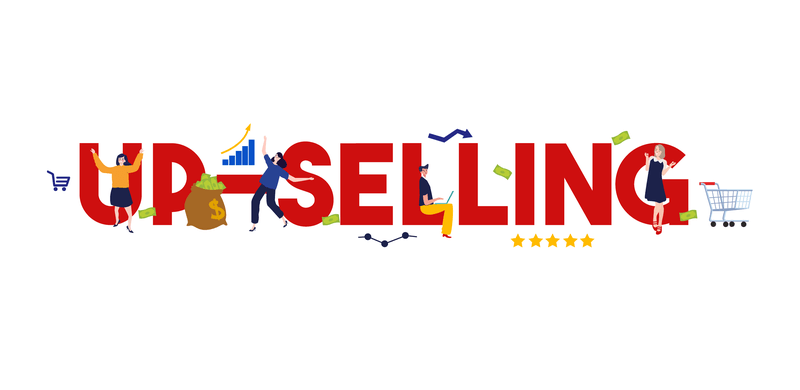What is upselling?
Upselling is a sales technique that persuades customers to buy an upgraded, expensive, or premium version of their chosen item or any add-ons that help make more sales. It is common for ecommerce businesses to combine both upselling and cross-selling techniques to increase the order value and profits from every purchase.
Benefits of upselling
Some customers experience negative feelings when faced with common sales techniques, so when done right, these techniques can improve their customer experience. Below is why retailers around the globe practice upselling:
Form meaningful relationships
When put into perspective, upselling is not a hard sales tactic. If your efforts to suggest premium deals help customers feel like ‘winning,’ such upgrades or add-ons offer greater value to the customers and form a deeper relationship with your brand. When customers feel they’ve secured a good deal, they will return for more shopping, and the ‘happiness tactic’ will generate additional revenue.
Sell to existing customers
Lead generation is expensive for any business. It is better and cheaper for a business to optimize their sale to a buyer already on the website and trust you with their money. If they have bought something from you in the past or are about to make a new purchase, they are still easier to target compared to a new visitor. Upselling is an easy win for ecommerce businesses on a lookout to accelerate their growth and improve their bottom line.
Boost customer lifetime value
Customer Lifetime Value or CLV is the accumulated profit a customer makes for your company over their lifetime. So you can categorize your customers into three tiers: profitable, not profitable, and highly profitable. High CLV means the customer makes more profit for you without spending anything extra. This leaves your company with more money to spend on customer acquisition and continue the cycle. Upselling is one of the most effective ways to turn your buyers into profitable customers and gives them some reason to keep coming back.
Keep customers engaged
Upselling is unique because it adds value to every purchase for a customer and motivates them to come back for more. By creating smooth user experiences and giving customers a chance to return to your shop in the future, you ensure better engagement. Remember that great customer service goes hand in hand with upselling and guarantees the customer leaves your store happily every time.
Difference between upselling andcross-selling
Both upselling and cross-selling are deployed in ecommerce to optimize revenue and increase the amount a customer spends on your products or services. Upselling convinces the customer to buy an upgraded version of a product or service, whereas cross-selling focuses on giving personalized recommendations of related products or services.

Best practices of upselling
You can use upselling in the following ways:
- Before purchase: You can display products or services at the bottom of the category page or on the sidebar.
- During Purchase: Show recommendations with the help of pop-ups, in the shopping cart, during checkout, or in your abandoned cart emails.
- After purchase: Use customized follow-up emails for a buyer and entice them to come back for more.
Successful upselling methods understand a customer’s needs and make the entire buying journey more enjoyable. A good upsell always makes the buyer feel like they won or got the best deal. Here are some best practices you can try today:
- Give incentives and reward your customers for spending more money on the store.
- Use side-by-side comparisons to show the value of the more expensive product.
- Make sure that the product you sell is within a reasonable price. Customers will not pay more than 25% of what they plan to spend.
- Do not be pushy and let the customer make up their mind.
- Create a sense of urgency and show real-time updates about an item. (only 2 left in stock!)
- Use customer data to personalize a deal as much as possible and suggest products that genuinely will add value to a purchase.
- Educate your customers about the risks, missed opportunities of not taking up an offer.
- Use the correct language to show them the benefits of buying or the risk of now buying a recommended product/service.
- Show a good collection of similar products but do not overwhelm your customer with too many choices.
Upselling strategies
Offer valuable upgrades
You need to offer something valuable when upselling and give upgrades that make sense. If you do not keep it reasonable, customers know that a recommendation is an overkill and ignore it. If the customer ignores your recommendation, it will defeat the purpose of upselling in the first place.
Don‘t be afraid of high prices
With an initial product choice, show expensive upgrades that the customer can think of buying instead. The tactic works because it is by no means pushy and lets your customers know about potential alternatives, even if they are a little pricey.
Recommend something popular
This strategy also uses a similar psychological trigger as the ratings one. If the customer chooses a basic product or service, you can step in and provide them with alternatives. Now, you can show them a pricier option and headline it as ‘Recommended’ out of all options. When customers compare this model with their current choice, they will find a better value in the pricier alternative.
Offer products with better ratings
One great way of upselling is to show similar products with higher ratings than the original one. So if your chosen product is showing 3-star ratings and the recommended section shows similar products with 4-star or more, you will choose the alternatives. It won’t be hard to convince customers to choose the 4-star product because they will feel the better quality. Objective data like ratings can be very persuasive.